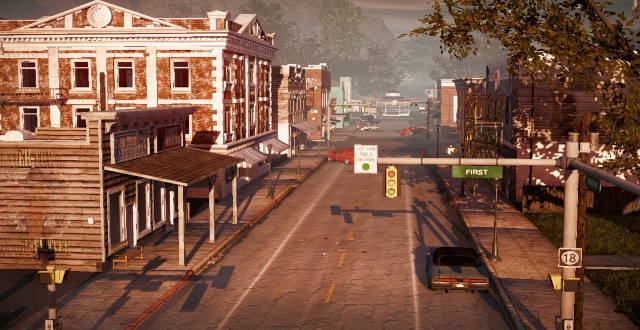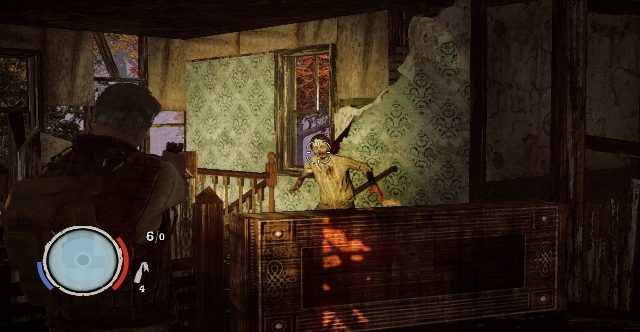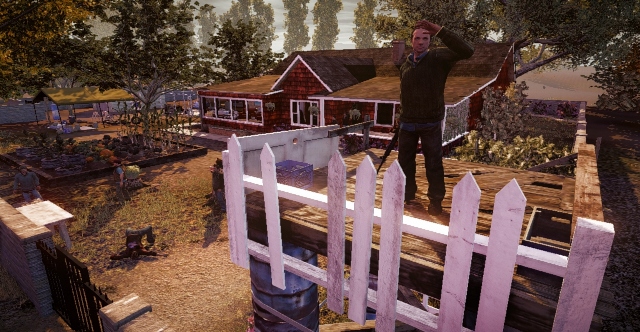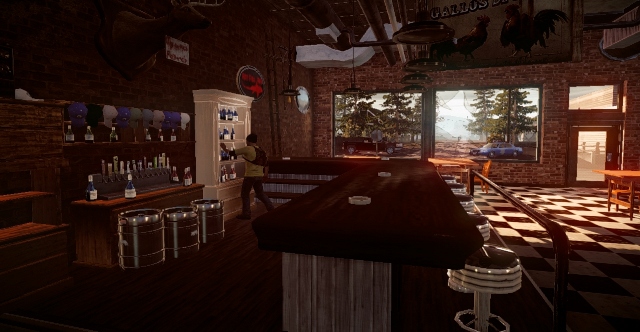Preview: State of Decay is a sandbox full of zombies shrouded in mystery
“This is by far the largest and most ambitious XBLA game ever made. No question,” Undead Labs CEO Jeff Strain said matter-of-factly of State of Decay when we spoke at PAX Prime. Though XBLA Fans has been unable to verify that claim, my brief time with the sandbox zombie game proved this much, at least: it’s huge. To put a measurement on it, Undead claims the overworld is 16 square kilometers.
In the demo, the player arms himself with a pistol and walks outside into deserted Anytown, USA. It is quickly apparent that not all living(ish) creatures have actually vacated the municipality. A few zombies shamble towards the player, as zombies are wont to do. Years of zombie games have prepared gamers for this situation; unloading a few shots into their noggins should eliminate the threat with little drama. Indeed it does, but they’ve got friends, and my, what big ears they have. There are small clusters of the undead doing their shambling thing on every block in sight. The unmistakable sound of gunfire alerts a couple of groupings of the town’s 99 percent, and, not the least bit concerned over the prospect of parting with the rotting lumps atop their necks, they quickly converge on the player’s location.
The first ones on the scene go down easily enough, but they just don’t make pistol clips big enough for this sort of job. Thankfully, Detroit was kind enough to make bumpers for just such an occasion. Jumping in an abandoned car, I stomp on the throttle and attempt, unsuccessfully, to make a controlled turn around the block. True to real life, the ’70s-looking muscle car is uncontrollable in anything other than a straight line.
Attempts to regain traction don’t go so well — not for me or for the zombies who thought it was a good idea to hang around in the middle of the road just past the intersection where irresponsible drivers are wont to swerve through, not the least bit concerned about braking for pedestrians. Zombies fly like bowling pins, inspiring another go at the group a bit farther down the road. The Undead Labs representative recommends motoring right on by to the side of them and hitting B. The car’s door is kicked open, and more zombies meet their end. At this point, it wouldn’t have been surprising if State of Decay‘s zombies began chanting “Braaaaaakes!” instead of “Braaaaains!”
Undead wisely chose to show off the sandbox action aspect of its game at the show rather than overload convention attendees with some of its more involving elements. Numerous members of the team insisted that there is more to the title than wasting jaywalkers, though. “We’re simulation-based,” explained Strain. “We have base-building, and we have a story. I’m actually really happy that the genre’s getting a lot of innovation right now. What’s really cool is that, if you look at the zombie games that are coming out soon, they’re all different! We’re finally starting to see something different than a corridor-shooter with orcs or Nazis or whatever. So I really appreciate that.
“What we’re really trying to do, though, is put you in a situation in a simulated world where you can answer the question ‘What would I do in the apocalypse?’” What indeed. How about seeing what else is out there? Surely not every location in the game world is as devoid of living humans and plagued by the undead as the town in the demo, right? Well, yes and no. Helicopters that occasionally fly overhead and some radio chatter coming across the airwaves will hint at a possibly better situation elsewhere. However, the game opens with the player returning from a trip into the mountains to a valley overrun by the mindless killers. According to Strain, the player is then trapped there and has “no idea what’s going on.”
Tech Artist Brant Fitzgerald, responsible for creating all of the game’s weapons, echoes that feeling of confusion. “The world has just gone to hell, right? And then you go from there trying to find your way,” he explained to XBLA Fans. “We do have a story that we’re not [showing yet]. But you’re running about, and the whole time you’re running about you’re picking up dynamic missions that sometimes you start yourself.”
A playthrough of the demo and all the talk from the dev team about playing around in a sandbox and being simulation-based naturally made me curious as to what the campaign is like, or if there even is one in the traditional sense of the word. Fitzgerald says there is. He elected not to reveal narrative details or how gamers will progress the story, though. Instead, he spoke of quests that develop in reaction to the decisions the player makes in the world when attempting to procure resources for building bases.
“Let’s say you go inside that house that you see,” he said. “You go inside and find a cache of materials that are useful for building that might help out. So, you run inside, you find that cache of materials, and then you have a choice then too. You might just break it open, and then you find a new melee weapon that’s going to replace [yours] that’s damaged, because that’s an immediate need that you need to fill. But if you need those materials [for building] the watchtower that will finish your base you may throw it all in your bag and take it home, or you can call somebody from your base to come pick it up.
“That in itself might generate more missions. Ten minutes later you might get a call from the guy you called — the guy that you sent there — and he might be like, ‘Dude, you’re a total ass. You sent me into the zombie homeland or something, and I’m stuck. Come help me.’ If you’re able to go help him, great. If not, there’s a good chance he’ll make it back to the base on his own. He may not have found any of that food, or he may have had to get rid of it on the way, so you’re down the materials that he went to find. But, he’s also pissed at you! Because you didn’t help him. He might go back and tell people that you’re not trustworthy, and they may not listen to you when you say, ‘I’m going to build a garden here.’ You may have to work your trust back up again.”
Strain was mostly tight-lipped about State of Decay‘s story as well, only willing to say that it’s a mystery to be uncovered as the game progresses. The playable characters — more on their plural nature shortly — are at a loss as to how their world devolved into a more literal version of California’s Death Valley in their absence. With no clear answers presenting themselves, they do what they can to start a new life in these less-than-optimal conditions.
Eventually, I’m told, they will uncover definitive answers. “And that is the thing, too — it is a sort of open sandbox game, but there is a story that interweaves as you discover certain characters, as you achieve certain things in upgrading your base,” said Strain. “Like you get some solar panels and that allows you to have power for the first time, and then that will allow you to go into areas that you’ve never seen before and find new clues and hints on your quest to — basically to exit this valley that you’re stuck in is your ultimate quest.”
Swaths of zombies are waiting to receive a car door to their midsection before that exit presents itself. To that end, many of those in the demo didn’t have long to wait. Driving out of town and into some farmlands provided an opportunity to splatter more of their kind. Having performed enough hit-and-runs for the time being, I hopped out and lobbed some grenades into a crowd my pursuers. Focusing on blowing that one group away allowed another to move in from behind for the kill. An Undead rep recommended letting them win. After he could endure no further melee attacks from the zombies, the player character was disemboweled in gruesome fashion. The developers and several attendees in line let out a collective “Ooooooooohhhhhhhh!” in response to the brutality. I stayed silent, but smiled appreciably at the impressively disgusting death sequence.
The game then cut away to a funeral ceremony back at the base — the playable character’s. Death is persistent in State of Decay. A dead character is dead forever, and a new survivor must pick up where he left off. Their fellow base-dwellers aren’t about to risk having their intestines forcibly exposed for just anyone, though. Their collective trust in the player is measured by a stat called “influence.”
“If you walk into a base and your influence is low and there’s an open spot to build the garden you say, ‘We need food, so we need to build a garden.’ If your influence isn’t high, if you haven’t gained [other residents’] trust or if somebody’s mad at you or something like that, they’re gonna be like, ‘No, I’m not gonna do that,’” explained Fitzgerald. “And so you may have to do some things to increase their trust in you.” Influence will also be important in the world as a whole, as word of your good (or bad) deeds will precede you. NPCs will then decide whether or not to help you based upon your prior actions. They’ll never get so angry as to attack the player, however. Undead Labs wanted to focus on man versus zombie, so even non-player characters that are desperate to survive and feel wronged by the player will stop short of attacking him.
Strain says State of Decay isn’t about “just surviving today, not just in this mall, or this corridor, or overnight or in this boat, but over weeks and months.” Would-be apocalypse survivors will need to hold out for a similar length of time until the game’s early 2013 release.





